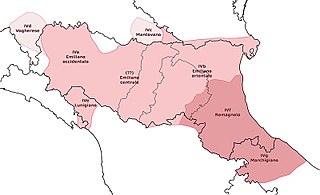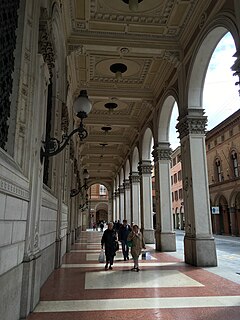 |
| Part of a series on |
| Fiddle and Violin |
|---|
| Violin acoustics |
| Fiddlers |
| History of the violin |
| Luthiers |
| Musical styles |
| Violin technique |
| Violin construction |
| Violin family |
| Violinists |
 |
| Part of a series on |
| Fiddle and Violin |
|---|
| Violin acoustics |
| Fiddlers |
| History of the violin |
| Luthiers |
| Musical styles |
| Violin technique |
| Violin construction |
| Violin family |
| Violinists |
.....


The province of Bologna was a province in the Emilia-Romagna region of Italy. Its provincial capital was the city of Bologna. The province of Bologna covered an area of 3,702.32 square kilometres (1,429.47 sq mi) and had a total population of 1,004,323 inhabitants as of 31 December 2014, giving it a population density of 271.27 inhabitants per square kilometre. It was replaced by the Metropolitan City of Bologna starting from January 2015.

Cento is a town and comune in the province of Ferrara, Emilia-Romagna, Italy.

Spilamberto is a comune (municipality) in the Province of Modena in the Italian region Emilia-Romagna, located about 25 kilometres (16 mi) west of Bologna and about 10 kilometres (6 mi) southeast of Modena.

Roberto Regazzi is a notable contemporary violin maker and scholar who received his initiation in the craft from Otello Bignami. Regazzi lives and works in Bologna.

Giuseppe Fiorini (1861–1934) was an Italian luthier and is considered one of the most important Italian violin makers. He built his first instrument at the age of 16 while working in Bologna. He established Rieger and Fiorini in Germany from 1888, then lived in Zurich during World War 1 and Rome from 1923.

Gaetano Pollastri (1886–1960) Gaetano, Augusto's younger brother, was a professional violinist but after the first world war he devoted himself to violin making. He worked with the same company as his brother in via Castiglione, that was devoted to the construction, repair and commerce of string instruments. In 1927 he received the Certificate of Honour at the contemporary violin making exhibition-competition in Cremona. When Augusto died in 1927, he took over his brother's company. In the following twenty years Gaetano constructed numerous instruments of which, in 1930, a violin with papal coat of arms that he personally donated to Pope Pious XI. He also restored precious violins; among them, a Stradivari and a Guarneri of Guglielmo Marconi brother's property, Alfonso. He won the Certificate of Honour in Cremona in 1949. In 1954 he showed two violins at the 2nd National Competition of Contemporary violin making in Rome, obtaining a Certificate of Honour, and was present with his instruments at the Ascoli Piceno ('54) and Pegli ('56) competitions. He worked very hard to promote his profession and was a founding associate of the ANLAI. His students include Cesare Pollastri, Franco Albanelli and Otello Bignami. - Il Suono di Bologna
Franco Albanelli was an Italian luthier, a pupil of Gaetano Pollastri.

Ansaldo Poggi was born in Villafontana di Medicina (Bologna), 9 June 1893 and died in Bologna, 4 September 1984. He demonstrated his talent for the making of stringed instruments at a young age. His father, also an artisan, musician and amateur violinmaker, encouraged his son, steering him toward the arts. After the end of World War I he dedicated himself to the profession, taking up the craft again alongside his father while at the same time graduating from the Philharmonic Academy of Bologna. In 1921 he met up with the famous luthier Giuseppe Fiorini, of whom he was an adored disciple. In 1923 he won his first silver medal with a viola at the National Competition in Rome.

Raffaele Fiorini, was an influential Italian violin maker.

Augusto Pollastri was a renowned Italian violin maker, older brother to Gaetano Pollastri. Started his career as an apprentice in Raffaele Fiorini's studio. Augusto's father was a miller and an amateur musician. Augusto was exposed to music early on, he also enjoyed visiting the shop of a famous violin maker Raffaele Fiorini, where he started to perform small services in the shop, which led to an apprenticeship with maestro Fiorini.

Emilian dialects are a group of closely-related dialects spoken in the historical region of Emilia, the western portion of today's Emilia-Romagna region, in Northern Italy.
The Derby dell'Emilia, is the name given in football to any match between Bologna F.C. 1909 and Parma Calcio 1913 Emilia is a region that approximately corresponds to the western and north-eastern portions of today's Emilia-Romagna. The region takes its name from the Via Aemilia, a Roman road in 187 BCE. It is contested twice a year when the two clubs participate in the same league competition, such as Serie A, and more often if the clubs meet in other competitions. Other matches between Emilian teams may also be referred to under the name Derby dell'Emilia. From the 2018–19 edition, with the return of Parma in Serie A three years after bankruptcy, the Derby dell'Emilia is again played.
Santa Maria della Carità is a Renaissance-style Roman Catholic church in central Bologna, Italy.

The Palazzo di Residenza della Cassa di Risparmio di Bologna is a 19th-century palace, erected as Neo-Renaissance architecture, located on Via Farini #22, Bologna, region of Emilia-Romagna, Italy. It was built and is still the headquarter of the Cassa di Risparmio in Bologna.
Cassa di Risparmio di Cento S.p.A. is an Italian savings bank based in Cento, Emilia-Romagna, which serve the Province of Ferrara, Bologna and Modena.